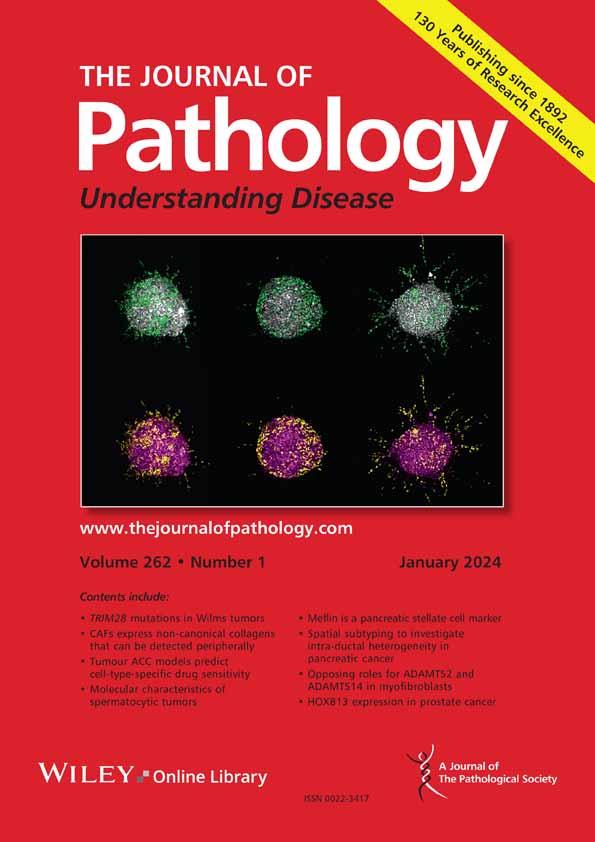Shouyi Tang, Qing Wang, Zhen Wang, Luyao Cai, Dan Pan, Jing Li, Qianming Chen, Yu Zhou, Ying-Qiang Shen
求助PDF
{"title":"NSD1 mutation status determines metabolic inhibitor sensitivity in head and neck squamous cell carcinomas by regulating mitochondrial respiration","authors":"Shouyi Tang, Qing Wang, Zhen Wang, Luyao Cai, Dan Pan, Jing Li, Qianming Chen, Yu Zhou, Ying-Qiang Shen","doi":"10.1002/path.6430","DOIUrl":null,"url":null,"abstract":"<p>Head and neck squamous cell carcinomas (HNSCCs) are the most common malignant tumors in the head and neck region, characterized by a high recurrence rate and early metastasis. Despite advances in treatment, patient outcomes and prognosis remain poor, highlighting the urgent need for new therapeutic strategies. Recent research has increasingly focused on targeting glucose metabolism as a therapeutic strategy for cancer, revealing multiple promising targets and potential drugs. However, the metabolic heterogeneity among tumors leads to variable sensitivity to metabolic inhibitors in different patients, limiting their clinical utility. In this study, we employed bioinformatics analysis, cell experiments, animal models, and multi-omics approaches to reveal differences in glucose metabolism phenotypes among HNSCC patients and elucidated the underlying molecular mechanisms driving these differences. Our findings showed that <i>NSD1</i> mutation status affects the glucose metabolism phenotype in HNSCC, with <i>NSD1</i> wild-type HNSCC exhibiting higher mitochondrial respiration and <i>NSD1</i> mutant HNSCC showing weaker mitochondrial respiration but enhanced glycolysis. We further demonstrated that <i>NSD1</i> regulates mitochondrial respiration in HNSCC via epigenetic modulation of the <i>TGFB2</i>/<i>PPARGC1A</i> signaling axis. Additionally, we found that <i>NSD1</i> wild-type HNSCC is more sensitive to mitochondrial respiration inhibitors, whereas <i>NSD1</i> mutant HNSCC shows increased sensitivity to glycolysis inhibitors. In summary, we found that <i>NSD1</i> can epigenetically regulate the <i>TGFB2</i>/<i>PPARGC1A</i> axis to modulate mitochondrial respiration and sensitivity to metabolic inhibitors in HNSCC. These findings suggest a novel strategy for selecting metabolic inhibitors for HNSCC based on the <i>NSD1</i> gene status of patients. © 2025 The Pathological Society of Great Britain and Ireland.</p>","PeriodicalId":232,"journal":{"name":"The Journal of Pathology","volume":"266 3","pages":"306-321"},"PeriodicalIF":5.2000,"publicationDate":"2025-05-15","publicationTypes":"Journal Article","fieldsOfStudy":null,"isOpenAccess":false,"openAccessPdf":"","citationCount":"0","resultStr":null,"platform":"Semanticscholar","paperid":null,"PeriodicalName":"The Journal of Pathology","FirstCategoryId":"3","ListUrlMain":"https://pathsocjournals.onlinelibrary.wiley.com/doi/10.1002/path.6430","RegionNum":2,"RegionCategory":"医学","ArticlePicture":[],"TitleCN":null,"AbstractTextCN":null,"PMCID":null,"EPubDate":"","PubModel":"","JCR":"Q1","JCRName":"ONCOLOGY","Score":null,"Total":0}
引用次数: 0
引用
批量引用
Abstract
Head and neck squamous cell carcinomas (HNSCCs) are the most common malignant tumors in the head and neck region, characterized by a high recurrence rate and early metastasis. Despite advances in treatment, patient outcomes and prognosis remain poor, highlighting the urgent need for new therapeutic strategies. Recent research has increasingly focused on targeting glucose metabolism as a therapeutic strategy for cancer, revealing multiple promising targets and potential drugs. However, the metabolic heterogeneity among tumors leads to variable sensitivity to metabolic inhibitors in different patients, limiting their clinical utility. In this study, we employed bioinformatics analysis, cell experiments, animal models, and multi-omics approaches to reveal differences in glucose metabolism phenotypes among HNSCC patients and elucidated the underlying molecular mechanisms driving these differences. Our findings showed that NSD1 mutation status affects the glucose metabolism phenotype in HNSCC, with NSD1 wild-type HNSCC exhibiting higher mitochondrial respiration and NSD1 mutant HNSCC showing weaker mitochondrial respiration but enhanced glycolysis. We further demonstrated that NSD1 regulates mitochondrial respiration in HNSCC via epigenetic modulation of the TGFB2 /PPARGC1A signaling axis. Additionally, we found that NSD1 wild-type HNSCC is more sensitive to mitochondrial respiration inhibitors, whereas NSD1 mutant HNSCC shows increased sensitivity to glycolysis inhibitors. In summary, we found that NSD1 can epigenetically regulate the TGFB2 /PPARGC1A axis to modulate mitochondrial respiration and sensitivity to metabolic inhibitors in HNSCC. These findings suggest a novel strategy for selecting metabolic inhibitors for HNSCC based on the NSD1 gene status of patients. © 2025 The Pathological Society of Great Britain and Ireland.
NSD1突变状态通过调节线粒体呼吸决定头颈部鳞状细胞癌代谢抑制剂的敏感性。
头颈部鳞状细胞癌(HNSCCs)是头颈部最常见的恶性肿瘤,具有复发率高、转移早的特点。尽管治疗取得了进展,但患者的预后和预后仍然很差,因此迫切需要新的治疗策略。近年来,越来越多的研究将葡萄糖代谢作为癌症的治疗策略,揭示了多种有希望的靶点和潜在的药物。然而,肿瘤之间的代谢异质性导致不同患者对代谢抑制剂的敏感性不同,限制了其临床应用。在这项研究中,我们采用生物信息学分析、细胞实验、动物模型和多组学方法揭示了HNSCC患者糖代谢表型的差异,并阐明了导致这些差异的潜在分子机制。我们的研究结果表明,NSD1突变状态影响HNSCC的糖代谢表型,NSD1野生型HNSCC表现出更高的线粒体呼吸,而NSD1突变型HNSCC表现出更弱的线粒体呼吸,但糖酵解增强。我们进一步证明,NSD1通过TGFB2/PPARGC1A信号轴的表观遗传调节HNSCC中的线粒体呼吸。此外,我们发现NSD1野生型HNSCC对线粒体呼吸抑制剂更敏感,而NSD1突变型HNSCC对糖酵解抑制剂的敏感性增加。总之,我们发现NSD1可以通过表观遗传调控TGFB2/PPARGC1A轴来调节HNSCC的线粒体呼吸和对代谢抑制剂的敏感性。这些发现提示了一种基于患者NSD1基因状态选择HNSCC代谢抑制剂的新策略。©2025英国和爱尔兰病理学会。
本文章由计算机程序翻译,如有差异,请以英文原文为准。




 求助内容:
求助内容: 应助结果提醒方式:
应助结果提醒方式:


